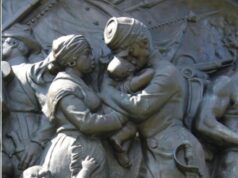by Charles Conner
The issue of statues and paraphernalia depicting Confederate generals and war leaders has been a hot topic since the 1890s, and it has only increased in relevance after the racist violence in Charlottesville that saw the murder of Heather Heyer.
At this time in our history it’s important to step back and examine Confederate symbolism and determine if it is truly a matter of heritage or a continuation of the Lost Cause school of thought that was prevalent in Virginia shortly after the war.
To understand Confederate statues and the ensuing crusade by members of the far right to protect them, it’s necessary to be knowledgeable about the Lost Cause and its effects on education and the southern conscience.
The Lost Cause was a ideological movement that took root in the Virginia and the larger South after northern troops were pulled out of the former Confederacy and white southerners regained political dominance following Reconstruction. The Lost Cause served to glorify Confederate soldiers and war leaders while at the same time minimizing the Confederacy’s role in causing the conflict.
One of the most prominent and egregious aspects of the Lost Cause is the belief that slavery was not a reason for the outbreak of the Civil War. Many organizations and historians — among the most prominent being the United Daughters of the Confederacy — sewed this narrative into the culture of Virginian life. This narrative has led to innumerable acts of violence and the creation of hate groups such as the Ku Klux Klan. Furthermore it has had the even more damaging effect of creating an environment of tolerance for hate groups.
The Lost Cause ideology and bitterness toward newly enfranchised African Americans was the reason that large numbers of Confederate statues were built after Reconstruction and when the KKK resurged in the 1920s and 1950s. This simple fact should be remembered, because it means Confederate statues symbolize hate rather than heritage. It’s also proof that the statues weren’t built to memorialize confederate soldiers. If they were built for that purpose they would have built after the directly after the conflict.
Virginia has only recently begun to extricate itself from the Lost Cause narrative — and only partly. There are still large swaths of the state in which the Lost Cause is still an important part of the understanding of our history, as seen in the Charlottesville riots. But the Lost Cause and the ghost of the Confederacy still haunt us in Fairfax County, as well. Confederate statues and historical markers dot the county and serve to glorify Confederate leaders, instead of telling clear historical truths about the men portrayed by the statues.
There are also still parts of public education curriculum that skew toward a Lost Cause point of view. On the 2018 US/VA standards of learning test for the question: “What was the cause of the Civil War?” According to the state, the correct answer was “states rights,” not slavery.
This obviously presents a false historical narrative and instills in our children damaging ideas about the Civil War, and by extension all post-1865 United States history. It excuses the vile nature of Confederate ideology, glorifies those who fought to maintain an abominable system of human oppression, and denigrates the memory of those who were forced to toil under the yoke of the American chattel slave system.
We need leadership in Fairfax County that will expunge the Lost Cause and our Confederate ghosts from both our social and educational systems. It is imperative that we have someone who will work to drag our Confederate path into the light so it can be seen for what it is. This must include taking down statues meant to glorify Confederate leaders.
I support Ryan McElveen for Board of Supervisors Chairman because he will lead on this fight. McElveen is a native son of Fairfax and a highly capable advocate for education. McElveen was a leading voice in renaming Jeb Stuart High School to Justice High, not just pushing for the renaming but also serving as a voice of reason throughout the entire process. He is the only candidate for Chairman who has voted to rename a monument to the Confederacy.
As Chairman, he will take further steps to root out the Confederate skeletons that reside in our collective closet. He is an impassioned anti-Confederate who has both the capacity and drive to see that our Confederate ties are cut and ensure that the future of our diverse county is one of pluralism and equality for all.





![Virginia NAACP: “This latest witch hunt [by the Trump administration] against [GMU] President Washington is a blatant attempt to intimidate those who champion diversity.”](https://bluevirginia.us/wp-content/uploads/2025/07/gmuwwashington-238x178.jpg)







